| machibouke | waiting in vain | |
| magatama | comma-shaped bead In the earliest period of Japanese history, magatama made of jade, amber, crystal, etc.were used to make necklace. |
|
| maibayashi | ||
| maitake | fan-shaped mushroom with multiple layers. Mai means dance, and take means mushroom. It is said that maitake is very tasty, and people who find it feels happy and starts dancing., then it got a name of maitake. |
|
| mamagoto |  |
playing house |
| mamemaki | ->Setsubun | |
| manaca | - | |
| maneki-neko |  |
a beckoning cat a kind of Japanese lucky charms |
| mangetsu |  |
full moon |
| manshon (mansion) マンション |
condominium, apartment house, flat | |
| maritsuki | playing with a ball like this | |
| masu |  |
a kind of measure |
| masuku |  |
mask. We wear mask not only when we catch cold but also protect from pollen or virus. |
| matcha | 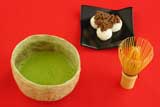 |
powdered green tea |
| matoi | ||
| matsubokkuri |  |
pine corn |
| matsunamiki | 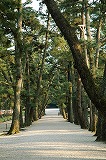 |
a row of pain trees |
| megane-bashi | 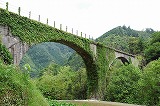 |
arched bridge |
| mejiro | 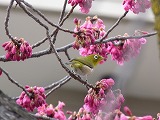 |
A Japanese white-eye |
| menko | old play among boys. Put a card on the ground. You beat your card on the ground and make the opponent's card overturning by the wind power, you can get it. |
|
| mikan |  |
mandarin orange |
| mikan no hana | 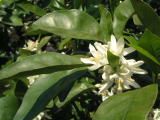 |
flowers of mikan (a pic above) |
| mikoshi | portable shrine | |
| Minami Alps | 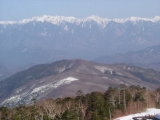 |
A part of the Japan Alps. another name of Akaishi Sammyaku |
| mino 蓑 | Mino is a straw raincoat | |
| mirin | 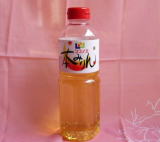 |
type of sweet sake used for cookikg. also used for o-toso (ceremonial drink for New Years) |
| miso | => miso | |
| miso-nikomi-udon | 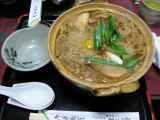 |
=> misonikomiudon |
| miso-shiru |  |
miso soup one of typical Japanese soup |
| Mitama Matsuri | - | Shinto Festival at Gokoku Jinja (shrine) Nagoya |
| mitarashi | 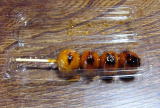 |
one of the very popular dumpling sweets |
| mitsuba |  |
Japanese wild chervil trefoil leaf used a garnish in soup, salad, etc. |
| mitsumata | Edgeworthia chrysantha Japanese paper called washi is made from mitsumata. |
|
| mitsume kozo | one of the traditional Japanese hobgoblins in folk tales "Mitsume" means three eyes and "kozo" means a young boy monk. |
|
| Miyajima | 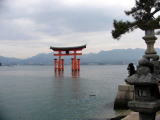 |
Miyajima is one of Japan's three most scenic places(Nihon-Sankei/日本三景) |
| miyakowasure |  |
Miyako-wasure (lit. forgetting the capital)/Gymnaster The origin of the name of Miyakowasure is came from an old poem composed by ex-Emperor Juntoku who had been exiled to Sadogashima (island) on a charge of the Jokyu Revolt in 1221. He was lost in longing for the capital, but finaly he found comfort in the modest flower, gymnaster. He planted it around his house and it helped him forget and heal his sorrow. Because it's similar to white chrysanthemum which his father, ex-Empror Gotoba, really loved. And chrysanthemum is also a symbol of the Imperial House. "いかにして契りおきけむ白菊を 都忘れと名づくるも憂し”(Ikanishite Chigiriokiken Shiragiku o, Miyakowasure to Nazukurumo ushi) |
mizugori |
Buddhist cold water ablutions |
|
| mizuko-jizo | Stone image of Jizo (guardian deity of children) that guard aborted, stllborn or miscarried foetus. | |
| mochi | 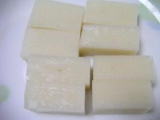 |
rice cake =>mochi-tsuki =>mochi-nage |
| momiji | 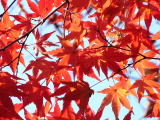 |
Japanese maple (tree) |
| momiji-manju | One of the most popular souvenir of Miyajima in Hiroshima Pref.. | |
| momiji mark | => koreisha mark | |
| momiji-no-hana | ||
| momiji-no-yona te | 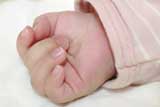 |
a baby's hands are often compared to Japanese maple leaves. |
| momo | 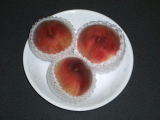 |
peach |
| morizuna 1 |  |
sand heaped up which used for shinto ritual, etc. |
| morizuna 2 | This kind of morizuna was settled between a gate and door of a samurai
house. If swords haven't been used for long time they become dull. So in case of emergency, samurai cut a morizuna several times their swords before rushing out. |
|
| moto-kano | "Moto 元" means former and "kano" is short for kanojo 彼女 which means a girlfriend. | |
| moto-kare | "Moto 元" means former and "kare" means a boyfriend. | |
| moyashi | 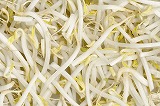 |
beansprouts |
| muen-baka(haka) | graves of no relatives | |
| mugi |  |
wheat |
| mugiwara-boshi | straw hat | |
| musha | 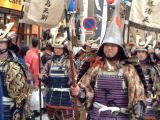 |
samurai or warriors |
| musha ningyo |  |
May 5th is Children's Day, a day to wish boys good health, happiness well-being. Around the time of this day, families with sons often display warrior dolls or miniture armor in their homes. |
| mushiba | caries teeth, dental caries | |
| mushimegane | 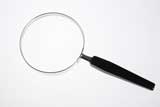 |
magnifying glass |
| mushi-tori/ (konchuu-saishuu) |
insect catching | |
| myoto-iwa | 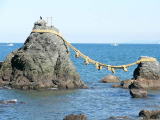 |
very famous pair of rocks. Myoto means a couple. They are at Futamigaura in Ise. The lope called shimenawa is changed to a new ones three times a year. May 5, Sept.5 and the 3rd Sunday of December. It's a must to see. |
| myouga | 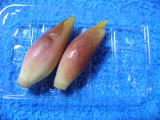 |
mioga Zingiher mioga. myoga buds are very fragrant whem thinly sliced and are used as a garnish. Salad with cucumbers and lettuce is nice. myoga pickles is also very good. |